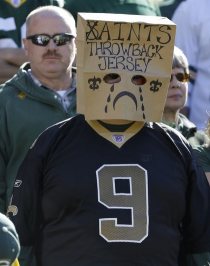Statistics were invented for a player like DeAngelo Hall. He isn’t that rare Shutdown Corner everybody lusts for — a Darrelle Revis or a Richard Sherman — and at going-on-31 his Pro Bowl years are probably behind him. The Redskins, strapped for cap dollars, deemed him expendable enough to release him during the 2013 offseason, though he eventually re-signed with them and played well enough to earn a four-year extension.
But Hall does have value, even if it’s declining. He may not be a great cover man, but he’s durable and — here’s where the stats come in — opportunistic. In fact, he’s the football equivalent of that guy at the beach with the metal detector. He’s always finding “loose change” by hanging around the ball. And he’s especially good at doing something with said ball once he latches onto it.
Stat No. 1: Because Hall came out of Virginia Tech early and was 20 when he played in his first NFL game, he played 143 games in his 20s. That gave him an unusual amount of time to make his statistical mark, and he took advantage of it. Consider: Since the big rule changes in 1978, the ones that turned the league into a Picnic for Passers, only one pure corner has had more picks in his 20s than DeAngelo did. The Top 10 looks like this:
MOST INTERCEPTIONS BY A CORNERBACK IN HIS 20S SINCE 1978
[table]
Seasons,Cornerback,Teams(s),Ints
1981-88,Everson Walls,Cowboys,44
2004-13,DeAngelo Hall,Falcons\, Raiders\, Redskins,42
1999-07,Champ Bailey, Redskins\, Broncos,42
2003-10,Asante Samuel,Patriots\, Eagles,42
1992-00,Terrell Buckley,Packers\, Dolphins\, Broncos,38
1991-97,Aeneas Williams,Cardinals,38
1996-03,Donnie Abraham,Bucs\, Jets,36
1988-95,Eric Allen,Eagles\, Saints,35
1995-03,Ty Law,Patriots,35
1989-96,Deion Sanders,Falcons\, 49ers\, Cowboys,34
[/table]
Note: Ronnie Lott (43) and Ray Buchanan (38) aren’t included because they got some of their interceptions at the safety spot (enough, at least, to take them below the cutoff of 34).
Granted, Hall has a tendency to gamble, but 42 picks are 42 picks, particularly in an era with low interception rates and a ton of one-possession games. Often, One More Takeaway can be the difference between victory and defeat. That’s what Hall, for all his flaws, gives you.
Stat No. 2: Last season Hall ran back two interceptions and one fumble for touchdowns. That brought his career totals in those categories to five and four. Only one other player in NFL history has returned at least four INTs and four fumbles for scores. Here are the 11 with 3 or more of each:
PLAYERS WITH 3 INTERCEPTION TDS AND 3 FUMBLE TDS, CAREER
[table]
Seasons,Player,Team (s),Int TD,Fum TD
1997-12,Ronde Barber,Bucs,8,4
2004-14,DeAngelo Hall,Falcons\, Raiders\, Redskins,5,4
1997-11,Jason Taylor,Dolphins\, Redskins\, Jets,3,6
2000-09,Mike Brown,Bears\, Chiefs,4,3
2000-09,Adalius Thomas,Ravens\, Patriots,3,3
1991-04,Aeneas Williams,Cardinals\, Rams,9,3
1988-00,Cris Dishman,Oilers\, Redskins\, 2 others,3,3
1989-98,Anthony Parker,Vikings\, 4 others,4,3
1969-81,Bill Thompson,Broncos,3,4
1970-82,Lemar Parrish,Bengals\, Redskins\, Bills,4,3
1964-79,Paul Krause,Redskins\, Vikings,3,3
[/table]
Not a bad bunch. Williams and Krause are in the Hall of Fame, Taylor is surely headed there and I’ve never quite understood why Parrish’s eight Pro Bowls and excellence as a returner don’t merit him serious consideration. Also, did you notice that five of the 11 played at one time or another for the Redskins (for whatever that’s worth)?
Anyway, like I said, DeAngelo Hall was made for stats.
Source: pro-football-reference.com

